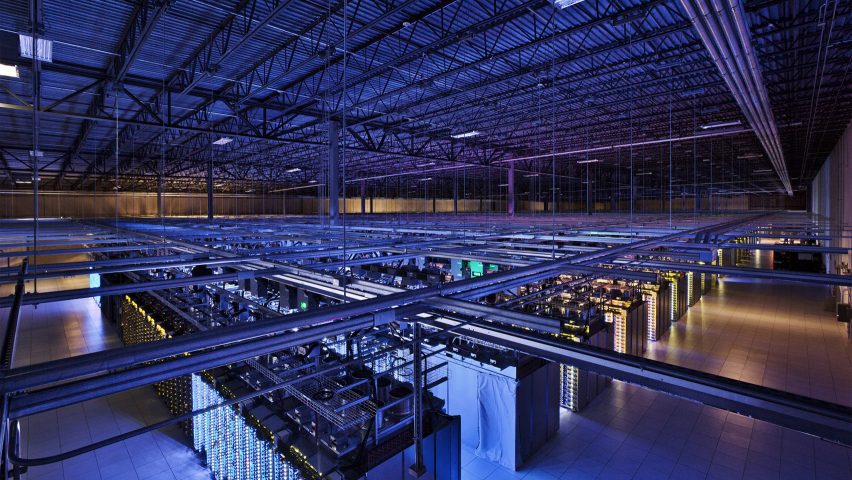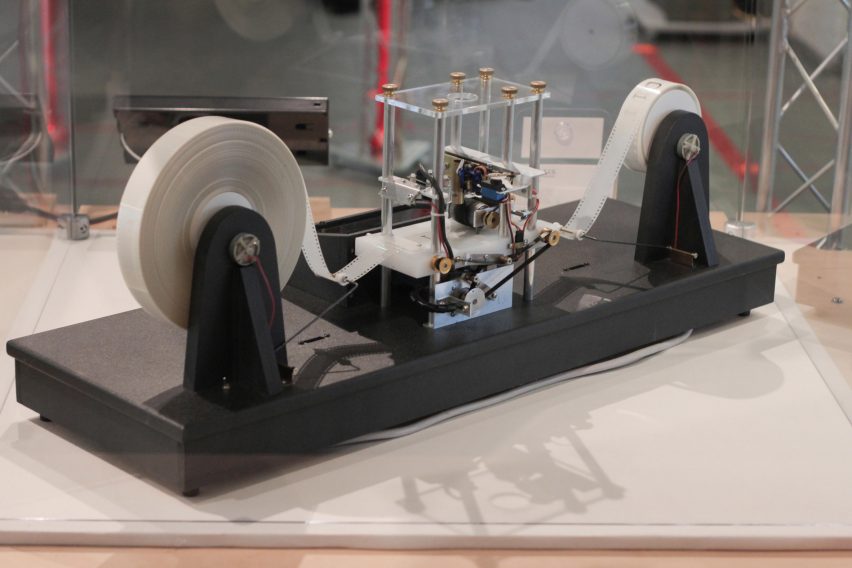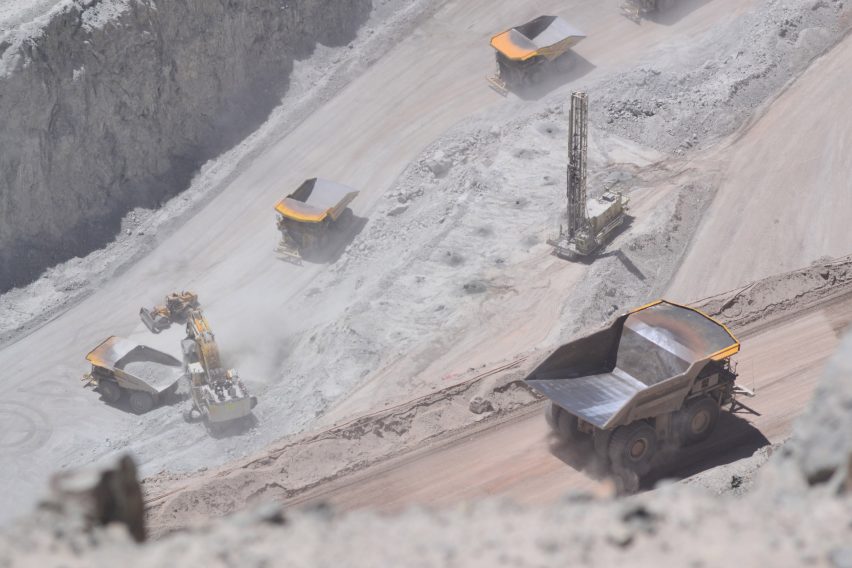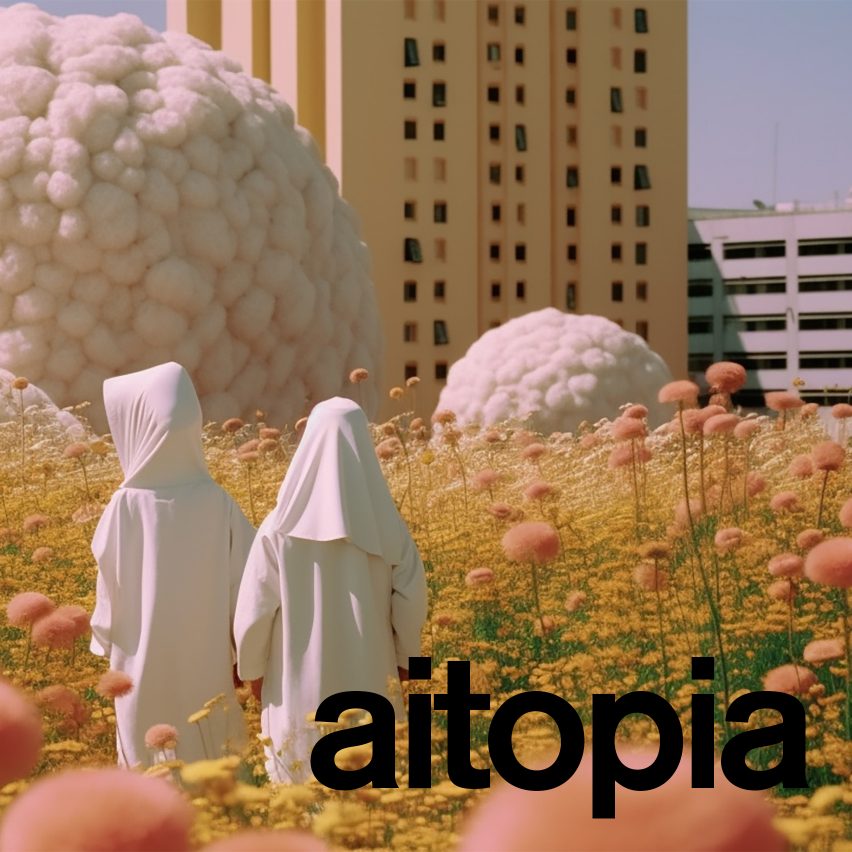
AI's "eye-watering" use of resources could be a hurdle to achieving climate goals, argue experts
The growth of AI will put an increased environmental burden on the planet, say experts who argue it's time to think about the invisible physical infrastructures of our technology.
In the 1930s, Alan Turing came up with an early conceptual model for computing. Later dubbed the Turing Machine, it involved a system with a head that reads and writes data bit by bit onto an infinite roll of tape, and it became a foundational idea in computer science.
Tech-focused artist and environmental engineer Tega Brain argues this idea of an infinite roll of tape is still echoed in the way society thinks about computing.
"The infinite roll of tape stands in for computing power," Brain told Dezeen. "At the very beginning of the field, they produced this imaginary of unlimited computing, and that's something that I think the field still aspires to."
"But also the roll of tape is paper, so it is material and therefore it is limited. An infinite roll is never going to be possible."

A growing community of academics are concerned with the environmental impact of our contemporary tendency to see the digital as divorced from the physical.
Online actions have a considerable material cost. The information and communications technology (ICT) sector has been credibly estimated to account for at least 2 to 4 per cent of global greenhouse gas emissions.
Aviation, a much more scrutinised sector, is estimated to account for 2 per cent of GHG emissions.
The chunk of emissions associated with ICT is expected to grow, in large part because of the boom in artificial intelligence (AI) and how much computing power it takes to train models on big data sets.
Increased energy demand a barrier to clean-energy goals
Experts tend to agree that the energy demands and related carbon emissions of AI are unlikely to be as alarming as they are for cryptocurrency and NFTs.
However, the trend for growth in AI, with more complex models becoming common, means this could change.
"AI may hold a promissory, high-tech vision of the future, but wherever that AI will live, it will look very beige, it will look unremarkable, it will have a huge impact on water tables and it will require a lot of electricity," warned Anne Pasek, a technology and climate researcher who recently published a zine called Getting Into Fights with Data Centres.
The technology's carbon footprint comes almost entirely from the energy use of its physical homes — the data centres that house their processing units.
There are at least 8,000 data centres worldwide, ranging in size from small office buildings to the "hyperscale" facilities — mostly owned by Amazon, Microsoft and Google — that power the cloud and span football fields.

Worldwide, estimated global data centre electricity consumption is around 240-340 terrawatt hours, or around 1 to 1.3 per cent of global demand, excluding cryptocurrency mining.
In Ireland, data centres use approximately 18 per cent of the country's total electricity, meaning its 70 data centres consume more energy than all the urban dwellings combined.
Data centres are becoming more efficient. While the number of facilities has doubled since 2015, and their workloads more than tripled, their energy use has gone up less, by somewhere between 20 and 70 per cent.
But Pasek points out that even a new "ultra-efficient, state-of-the-art, ecological angel facility" still represents additional demand on the grid overall.
"It may be cleaner than before, but if all we're doing is making efficiency improvements, we're not really changing the trajectory overall," she said.
"Our best strategy to address climate change is to electrify everything and make electricity clean, but it will be exponentially harder to achieve that goal if we don't also reduce demand at the same time," Pasek continued.
Calculating AI's share of this energy bill is difficult. One study from 2019 suggested training a single deep learning model could use between 27 and 656,347 kilowatt hours of electricity, producing five times the lifetime carbon emissions of a car.
This is widely viewed as an extreme example, but Brain noted that "the resources that would be being used by something like OpenAI, with its unprecedented adoption, will be eye-watering".
"We have to always have that big asterisk there that it's kind of a guess in the dark," said Pasek. "That means that the real question is not 'how bad is our current stuff', but rather, what sort of future plans, deployments and business models are being dreamt up?"
Competition for scarce water supplies
Data centres also use huge amounts of water for the cooling systems that keep their racks of servers from overheating.
In one contentious study, researchers estimated that for every ChatGPT conversation of 20-50 questions, a 500-millilitre bottle of water would be "drunk" at a data centre.
But while the water consumption of a particular process such as using or training an AI is hard to quantify, the figures for the data centres themselves are more concrete.
After years of secrecy, Google has started publishing its usage statistics, reporting that its data centres worldwide used 5.2 billion gallons of water in 2022.
In her zine, Pasek uses Google's data centre in The Dalles, Oregon as a case study, noting that the 350 million gallons of water it uses accounts for almost a third of the water use for the whole city of 16,000 residents.

That number is set to grow with the planned opening of two more data centres there, but some experts have warned this could affect fish and wildlife on source water streams, as well as other water users.
"It's a very significant demand put on local infrastructure," said Pasek. "And it also means that the water table of the region is under stress. If there's a drought, then data centres can be in competition with agriculture and with city usage."
In some areas of the world, droughts have already brought local people into conflict with data centres.
This year in the Uruguayan capital of Montevideo, residents suffering under water shortages so severe that saltwater had been added to the drinking supply protested against plans to build a Google data centre there.
After the 2021 heatwave in the Netherlands, farmers led an opposition movement that even saw the country institute a nine-month ban on the building of new centres.
Tech needs linked to boom in mining
With AI, the drive to build more data centres, hardware and energy infrastructure also has a cost in carbon-intense raw materials ranging from concrete and steel to aluminium, plastic, glass, silicon, copper, gold and rare earth minerals.
Worldwide demand for lithium — a key battery metal — is expected to grow to 1.1 million metric tons by 2040, more than 10 times what is currently produced, and nearly all of that will be used for electric vehicles or energy storage.
A key issue is that the metals and minerals need to be mined, and — particularly given the technology industry's slow embrace of e-waste recycling and circularity — that creates an environmental and social burden that rich Western countries have mostly exported to the Global South.
Architect and researcher Antonio del Giudice , who has worked with indigenous communities in Chile whose lands are being used for mining copper and lithium, said that Europe has written off whole regions as "sacrificed zones" for mining.

There are issues with what happens to these materials at end-of-life, too.
While some leaders in the tech industry, including Google, are making progress, most disused parts from data centres still end up in landfill with electronic waste estimated to account for around 70 per cent of the world's surface-level toxic pollution.
Most of the parts from decommissioned data centres finish up in places like the Agbogbloshie "digital dumping ground" in Ghana, with electronic waste estimated to account for around 70 per cent of the world's surface-level toxic pollution.
By contrast, there is at least one area of ICT infrastructure that is relatively unproblematic: the undersea cables that connect up data centres and send information flying around the globe via fibre optics. They are made mostly of glass fibre, steel and copper.
Researcher Nicole Starosielski — who wrote the book on the subject — told Dezeen that the cables use relatively small amounts of electricity, produce little carbon emissions and have a negligible effect on the marine environment.
She even wants more cables to be laid to give more isolated nations a better back-up against damage and to connect more parts of the world with data centres in the most low-impact locations.
"[The cables] are the size of a garden hose, stay in place for 25 years, and are largely neutral," said Starosielski. "I would advocate for laying more cables, especially to connect to data centres in green energy hubs."
Rethinking technology and material use
Some AI researchers argue that it promises major environmental benefits, from finding efficiencies to making a big breakthrough on nuclear fusion for renewable energy.
But others are calling for sustainability to have more prominence in ethical guidelines for AI. Charlotte Freitag, Mike Berners-Lee and their co-authors on the ICT sector emissions paper note that sustainability is currently one of the least represented issues in these exercises, but that its inclusion could help to change the paradigm.
Brain, meanwhile, identifies a potential role for front-end designers, who could introduce a transparency around material use into interfaces to encourage people to view the digital world as entwined with the planet's resources.
Brain advocates for design within planetary limits, and her own artwork, Solar Protocol, is a provocation to think about what the internet might look like if we accept the intermittency of solar power.
"The way that interfaces are designed is to make their content appear as if by magic," she said. "There's no disclosure around the resources or the context that the system is operating in. Smooth, seamless design is deliberately about making that opaque."

AItopia
This article is part of Dezeen's AItopia series, which explores the impact of artificial intelligence (AI) on design, architecture and humanity, both now and in the future.
Dezeen In Depth
If you enjoy reading Dezeen's interviews, opinions and features, subscribe to Dezeen In Depth. Sent on the last Friday of each month, this newsletter provides a single place to read about the design and architecture stories behind the headlines.